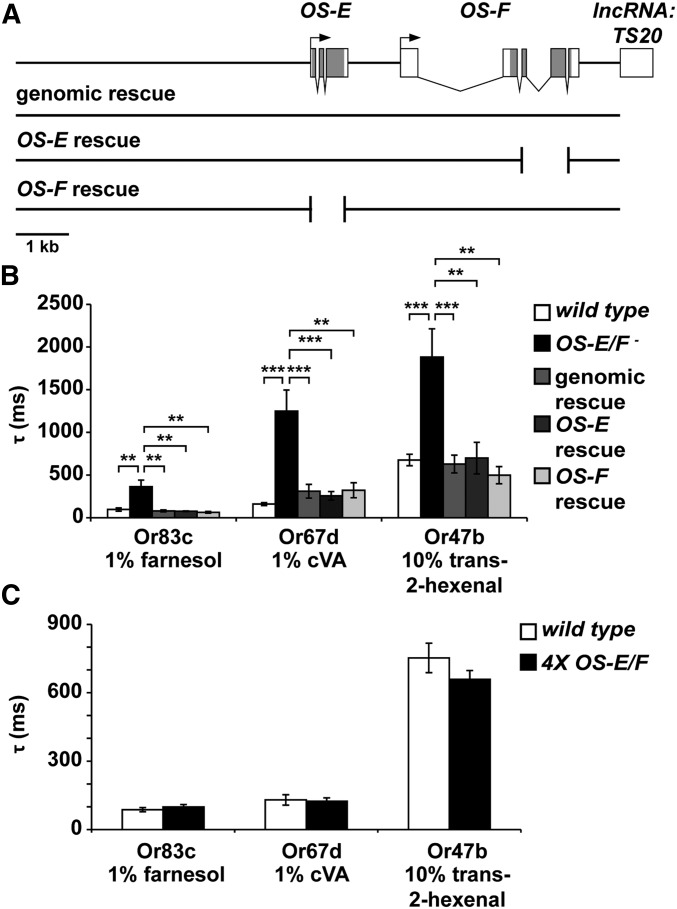Figure 7.
OS-E and OS-F are functionally redundant for rapid neuronal deactivation. (A) Map of the OS-E/F gene region with black rectangles depicting coding regions. Arrows indicate transcription start sites. The lines beneath the map depict the DNA deletions that were used to evaluate the function of individual OBP genes. Breaks in the lines showing individual rescues show where the coding regions of either OS-E or OS-F were excised from the genomic rescue construct (see Materials and Methods for details). (B) Time constants of deactivation for Or83c, Or67d, and Or47b neurons with the genotypes indicated. Delayed deactivation present in the OS-E/F mutants is reversed by all three forms of the rescuing transgene. Deactivation time constants for Or83c neurons to farnesol (left side of graph): wild-type = 96.36 ± 19.24 msec, OS-E/F mutant = 375.98 ± 83.94 msec, genomic rescue = 75.34 ± 12.31 msec, OS-E rescue = 76.54 ± 4.15 msec, and OS-F rescue = 63.79 ± 9.48 msec. ANOVA P-values: wild-type to OS-E/F mutant = 0.0013, OS-E/F mutant to genomic rescue = 0.001, OS-E/F mutant to OS-E rescue = 0.0013, and OS-E/F mutant to OS-F rescue = 0.003, all nonsignificant P-values = 0.99. For Or67d responses to cVA (center part of graph): wild-type = 160.73 ± 17.23, OS-E/F mutant = 1249.58 ± 246.56, genomic rescue = 310.43 ± 80.34, OS-E rescue = 257.52 ± 50.11, and OS-F rescue = 322.24 ± 88.65. ANOVA P-values: wild-type to OS-E/F mutant = 9.8 × 10−5, OS-E/F mutant to genomic rescue = 0.0019, OS-E/F mutant to OS-E rescue = 0.0016; OS-E/F mutant to OS-F rescue = 0.0013, wild-type to genomic rescue = 0.90, wild-type to OS-E rescue = 0.98, wild-type to OS-F rescue = 0.94, genomic rescue to OS-E rescue = 0.99, genomic rescue to OS-F rescue = 0.99, and OS-E rescue to OS-F rescue = 0.99. For Or47b responses to trans-2-hexenal (right part of graph): wild-type = 676.42 ± 64.24 msec, OS-E/F mutant = 1882.5 ± 328.9 msec, genomic rescue = 629.12 ± 102.74 msec, OS-E rescue = 699.18 ± 184.7 msec, and OS-F rescue = 499.1 ± 99.4 msec. ANOVA P-values: wild-type to OS-E/F mutant = 2.5 × 10−4, OS-E/F mutant to genomic rescue = 3.8 × 10−4, OS-E/F mutant to OS-E rescue = 0.004, OS-E/F mutant to OS-F rescue = 0.001, wild-type to genomic rescue = 0.70, wild-type to OS-E rescue = 0.90, wild-type to OS-F rescue = 0.14, genomic rescue to OS-E rescue = 0.73, genomic rescue to OS-F rescue = 0.40, and OS-E rescue to OS-F rescue = 0.39. n = 5–10. Error bars indicate SEM. All P-values determined by one-way ANOVA with post hoc Tukey’s test. (C) Extra copies of OS-E and OS-F do not alter deactivation kinetics. Time constants of deactivation for Or83c, Or67d, and Or47b neurons with the genotypes indicated. Deactivation time constants for Or83c neurons to farnesol (left side of graph): wild-type = 87.13 ± 9.2 msec, 4X OS-E/F= 99.6 ± 9.9 msec, P = 0.43. For Or67d responses to cVA (center part of graph): wild-type = 130.1 ± 22.9 msec, 4X OS-E/F = 124.3 ± 14.2, P = 0.83. For Or47b responses to trans-2-hexenal (right part of graph): wild-type = 752.65 ± 64.6 msec, 4X OS-E/F = 658.7 ± 38.8 msec, P = 0.52. cVA, 11-cis vaccenyl acetate; lncRNA, long noncoding RNA; OBP, odorant-binding proteins.

